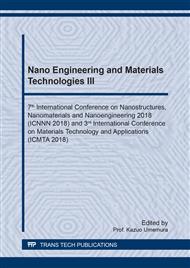p.185
p.190
p.195
p.200
p.207
p.212
p.217
p.222
p.228
Mixture Proportioning Design of Pervious Concrete Using the Paste Content Ratio Method (Aggregate Gradation 19mm~9.5mm and 9.5mm~4.75mm)
Abstract:
In this work, we used the concept of paste content ratios in the mixture proportioning design of pervious concrete so that the concrete paste content could be adjusted to satisfy the requirements of different engineering applications. We experimentally demonstrated that compressive strength is negatively correlated with the coefficient of permeability and positively correlated with the paste content ratio. The highest compressive strength achieved in this study was 340 kgf/cm2, whereas the highest permeability coefficient was 0.116 cm/s. Design graphs for flowability, compressive strength, and permeability coefficient of the concrete mixtures were also constructed to be used by engineering companies as reference data.
Info:
Periodical:
Pages:
207-211
Citation:
Online since:
March 2019
Authors:
Price:
Сopyright:
© 2019 Trans Tech Publications Ltd. All Rights Reserved
Share:
Citation:


